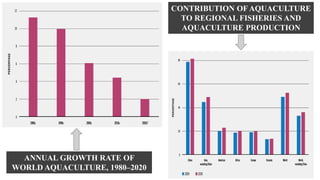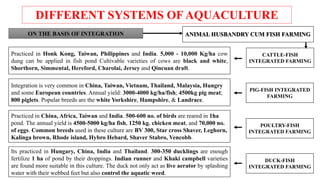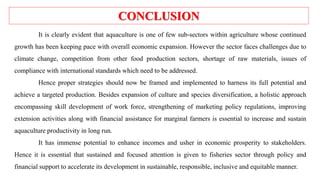Present status, Constraints, future prospects and different Aquaculture practices in India and the world
- 1. PRESENT STATUS, CONSTRAINTS, FUTURE PROSPECTS AND DIFFERENT AQUACULTURE PRACTICES IN INDIA AND THE WORLD SUBMITTED BY: Krina D. Patel, Ph.D. (Aquaculture), Semester : 1 SUBMITTED TO: Dr. K. H. Vadher, Associate Professor, College Of Fisheries Science, Veraval COLLEGE OF FISHERIES SCIENCE, VERAVAL AQC 601 Hi-tech Aquaculture Production Systems
- 2. Total fisheries and aquaculture production: 214 million tonnes in 2020 Aquatic animal production: 178 million tonnes Algae production: 36 million tonnes Human consumption (excluding algae) was 20.2 kg per capita in 2020 International trade of fisheries and aquaculture products are around USD 151 billion in 2020 GLOBAL FISHERIES AND AQUACULTURE PRODUCTION
- 3. GLOBALAQUACULTURE PRODUCTION Global aquaculture production: 122.6 million tonnes, total value of USD 281.5 billion Aquatic animals production: 87.5 million tonnes (Use as a human food) Algae production: 35.1 million tonnes ( Both food and non-food uses) Shells and pearls: 700 tonnes ( Ornamental use)
- 4. INLAND AQUACULTURE: 54.4 million tonnes (44.4 % of the world total aquaculture production MARICULTURE AND COASTALAQUACULTURE PRODUCTION: 68.1 million tonnes, including 33.1 million tonnes of aquatic animals and 35 million tonnes of algae. Finfish production: 57.5 million tonnes (66 percent % of total aquaculture production) Inland aquaculture (Finfish): 49.1 million tonnes Mariculture and coastal aquaculture (Finfish): 8.3 million tonnes Molluscs production: Bivalves production: 17.7 million tonnes Crustaceans production: 11.2 million tonnes Aquatic invertebrates production: 525 000 tonnes Turtles and frogs production: 537 000 tonnes AQUACULTURE CONTRIBUTION TO TOTAL FISHERIES AND AQUACULTURE PRODUCTION
- 5. MAJOR SPECIES GROUP CONTRIBUTION IN TOTAL PRODUCTION FINFISHES (INLAND) FINFISHES (MARICULTURE & COASTAL AQUACULTURE) CRUSTACEAN MOLLUSCS ALGAE OTHER AQUATIC ANIMALS Grass carp (11.8%) Atlantic salmon (32.6%) Whiteleg shrimp (51.7%) Cupped oyster (30.7%) Japanese kelp (35.5%) Chinese softshell turtle (31.5%) Silver carp (10%) Milkfish (14%) Red swamp crawfish (22%) Japanese carpet shell (24%) Eucheuma sp. (23.2%) Japanese sea cucumber (19%) Nile tilapia (9%) Mullets nei (3.5%) Chinese mitten crab (6.9%) Scallops nei (9.8%) Gracilaria sp.(14.8%) Frogs (13.9%)
- 6. PRODUCTION DISTRIBUTION AND MAJOR PRODUCERS 91.61 3.59 2.69 1.92 0.19 0 10 20 30 40 50 60 70 80 90 100 GLOBAL AQUACULTURE PRODUCTION ( BOTH ANIMAL AND ALGAE) IN % ASIA China (mainland) (62.77%) Indonesia (13.22%) India (7.70%) Viet Nam (4.11%) Bangladesh (2.30%) Rest of Asia (9.91%)
- 7. ANNUAL GROWTH RATE OF WORLD AQUACULTURE, 1980–2020 CONTRIBUTION OF AQUACULTURE TO REGIONAL FISHERIES AND AQUACULTURE PRODUCTION
- 8. DEMAND- CONSUMPTION SCENARIO The seafood industry remains primarily a commodity market. Demand is driven by population trends, income, regional and global tastes, and the availability and price of protein substitutes. Seafood consumption is reasonably well correlated with GDP per capita growth. With the world population expected to reach 9.7 billion by 2050, global demand for seafood is likely to grow rapidly, and aquaculture will account for most, if not all, of that growth. Seafood consumption has more than doubled, from 9.9 kg per capita in the 1960s to an average of 20.2 kg, due to the nutritional importance of fish and technological advances allowing for increased accessibility of seafood products.
- 9. INCREASING ROLE OF AQUACULTURE WORLD FISHERIES AND AQUACULTURE PRODUCTION: UTILIZATION AND APPARENT
- 10. INDIAN FISHERIES AND AQUACULTURE PRODUCTION Total fish production: 162.48 lakh tonnes Marine fish production: 41.27 lakh tonnes Marine and Inland fisheries average annual growth rate was 18.7 % and 7.76 %. Annual growth rate was 10.34% Inland fish production: 121.21 lakh tonnes Contribution of fisheries sector in Indian economy (2020-21): 1.1% Contribution of economy of Fisheries sector in agriculture (2020-21): 6.72% Contribution of India to World fish production: 8% Per. Capita consumption of fish: 6.31
- 11. INLAND FISH PRODUCTION Fish production in India has witnessed a tremendous growth by showcasing a production increase from 0.75 million MT during 1950-51 to the current production of 14.1 million MT. The unutilized and underutilized vast and varied resources, in the form of 191,024 km of rivers and canals, 1.2 million Ha of floodplain lakes, 2.36 million Ha of ponds and tanks, 3.54 million Ha of reservoirs and 1.24 million Ha of brackish water resources offer great opportunities for enhanced production along with livelihood development and ushering economic prosperity. Inland fisheries contribute about 74% in total fisheries.
- 12. Freshwater aquaculture contributes nearly more than 80%. Of total inland fish production. Now India is second largest farmed fish producer in the world Dominated by IMC and Exotic carps. National average Productivity is 3 t/ha. States like Andhra Pradesh and West Bengal average productivity is 8- 12 t/ha. India has around 2.36 million Ha of Tanks & Ponds area where culture-based fishery is predominant and contributes to the maximum share in total fish production. The current production from tanks and pond is 8.5 million MT. Brackish water aquaculture offers huge potential as the country has around 1.42 million Ha of brackish/saline area, of which only 13% is utilized. Current fish production is 0.7 million. India is bestowed with vast and varied cold water resources with valuable indigenous fish germ plasm and pristine water with a range of thermal regimes. Current cold water fish production is 52,084 MT and current productivity is 1 ton/Ha. INLAND FISH PRODUCTION
- 13. INLAND FISH PRODUCTION Ornamental fisheries has immense export potential, it is a multibillion industry spread across more than 125 countries with trade at retail level worth US $18 - 20 billion. However, for India it is estimated around Rs.500 Cr. Reservoirs are generally referred to as ‘sleeping giants’ as in spite of large area covered it cage culture contributes to ~3.81% of the total inland fish production. Potentiality of reservoir is 3.54 million Ha. Current fish production through cage culture of 2.44 lakh MT. India is bestowed with 14 major, 44 medium, and numerous minor rivers that run through 2.52 lakh Kms contributes to current production of 1 Lakh ton. The natural wetlands of the country are being developed by keeping ecological integrity of important natural wetlands through promotion of sustainable fishing practices thus contributing to the current production of 2.03 lakh ton through 5.5. lakh Ha available area.
- 14. INLAND FISH PRODUCTION 42.19 16.52 8.09 7.89 7.62 STATE WISE FISH PRODUCTION ( IN LAKH TONNES) AP WB UP OD BR 62.97 14.33 5.51 5.32 5.32 20.85 SPECIES WISE INLAND FISH PRODUCTION ( IN LAKH TONNES) MAJOR CARPS EXOTIC CARPS CAT FISHES MINOR CARPS MURRELS OTHER FW SPECIES
- 15. TOTAL FISH SEED PRODUCTION ( IN LAKH TONNES) 124550 114950 98860 38126 32331.2 STATE WISE FISH SEED PRODUCTION ( IN LAKH) WEST BENGAL JHARKHAND ASSAM ANDHRA PRADESH UTTAR PRADESH
- 16. DIFFERENT SYSTEMS OF AQUACULTURE ON THE BASIS OF INTENSITY ON THE BASIS OF SALINITY ON THE BASIS OF FISH SPECIES FRESHWATER FARMING BRACKISHWATER FARMING MARINE WATER FARMING EXTENSIVE FARMING POLYCULTURE MONO CULTURE INTENSIVE FARMING SEMI-INTENSIVE FARMING
- 17. DIFFERENT SYSTEMS OF AQUACULTURE ON THE BASIS OF ENCLOSURE POND CULTURE CAGE CULTURE PEN CULTURE RACE-WAY CULTURE RECIRUCULATING AQUACULTURE SYSTEM water is maintained in an enclosed area by artificial construction of dike/bund. Ponds are usually filled by rain, canal water and by man-made bores. They differ widely in shape, size, topography, water and soil qualities. Japan, South Korea, China, Philippines, Thailand, Malaysia, Germany, Norway, USA are some of the countries where cage culture is well developed. Species cultured in cages are carps, tilapia, trout, catfishes, etc. Mostly shallow regions along shores and banks of the lakes and reservoirs are consider for pen culture. Pen culture is practiced in China, Japan, Philippines etc. IMC, exotic carps, milk fish, sea bass are cultured in pens. High stocking density and high production. Trout, catfish and tilapia also used for culturing juvenile salmon, brackish water sea bass and sea bream and abalone. Practiced in USA, Norway, China, South Korea and many more. Asian Seabass, Cobia, Silver Pompano, Tilapia, Pearl spot, Pangasius and Rainbow Trout are suitable for RAS. RAS developed in China, USA, some European countries and south east Asian region.
- 18. DIFFERENT SYSTEMS OF AQUACULTURE POND CULTURE RACE-WAY CULTURE PEN CULTURE CAGE CULTURE RAS
- 19. DIFFERENT SYSTEMS OF AQUACULTURE ON THE BASIS OF INTEGRATION AGRICULTURE CUM FISH FARMING RICE-FISH INTEGRATED FARMING HORTICULTURE-FISH INTEGRATED FARMING MUSHROOM-FISH INTEGRATED FARMING SERI-FISH INTEGRATED FARMING Practiced in China, Bangladesh, Malaysia, Korea, Indonesia, Philippines, Thailand and India. Varieties like Tulsi, Panidhan, CR260, ADT 6, ADT7, Rajarajan and Pattambi 15 and 16 are suitable. Candidate fish species are Common carp, Tilapia and Murrells. Cultivation requires high degree of humidity and oxygen aquatic environment is suitable. Farming done in Germany, India, China, Madagascar and Russia. Agaricus bisporus, Voloriella spp. and Pleurotus spp., are commercially cultured mushrooms in India. These culture techniques followed by China, Hungary, Germany, India and Malaysia. The top, inner and the outer dykes can be planted with dwarf variety coconut, mango and banana. And the side by land can be used for planting pineapple, ginger, and turmeric and chilly. Farming practiced in China, France, Italy, Japan, Korea, and Russia. Mulberry leaves produced is primarily consumed by the silk worm and the faeces of the silk worm is directly applied to the fish pond to increase of natural food organism-detritus and bacteria in fishpond.
- 20. RICE-FISH INTEGRATED FARMING HORTICULTURE-FISH INTEGRATED FARMING MUSHROOM-FISH INTEGRATED FARMING SERI-FISH INTEGRATED FARMING
- 21. DIFFERENT SYSTEMS OF AQUACULTURE ON THE BASIS OF INTEGRATION ANIMAL HUSBANDRY CUM FISH FARMING CATTLE-FISH INTEGRATED FARMING DUCK-FISH INTEGRATED FARMING POULTRY-FISH INTEGRATED FARMING PIG-FISH INTEGRATED FARMING Practiced in Honk Kong, Taiwan, Philippines and India. 5,000 - 10,000 Kg/ha cow dung can be applied in fish pond Cultivable varieties of cows are black and white, Shorthorn, Simmental, Hereford, Charolai, Jersey and Qincuan draft. Integration is very common in China, Taiwan, Vietnam, Thailand, Malaysia, Hungry and some European countries. Annual yield: 3000-4000 kg/ha/fish; 4500kg pig meat; 800 piglets. Popular breeds are the white Yorkshire, Hampshire, & Landrace. Practiced in China, Africa, Taiwan and India. 500-600 no. of birds are reared in 1ha pond. The annual yield is 4500-5000 kg/ha fish, 1250 kg. chicken meat, and 70,000 no. of eggs. Common breeds used in these culture are BV 300, Star cross Shaver, Leghorn, Kalinga brown, Rhode island, Hybro Hebard, Shaver Stabro, Vencobb. Its practiced in Hungary, China, India and Thailand. 300-350 ducklings are enough fertilize 1 ha of pond by their droppings. Indian runner and Khaki campbell varieties are found more suitable in this culture. The duck not only act as live aerator by splashing water with their webbed feet but also control the aquatic weed.
- 22. POULTRY-FISH INTEGRATED FARMING CATTLE-FISH INTEGRATED FARMING PIG-FISH INTEGRATED FARMING DUCK-FISH INTEGRATED FARMING
- 23. DIFFERENT CATAGORIES OF AQUACULTURE 1) Based on temperature of water a) Warm water farms b) Cold water farms 2) Based on water replacement a) Running water farms b) Stagnant water farms 3) Based on physiographical zone a) Inland fish farms b) Coastal fish farms c) Marine fish farms 4) Based on water source a) Rain fed farms b) Tide fed farms c) Ground water fed farms d) River/Canal fed farms e) Spring water/Artesian fed farms f) Sewage fed farms g) Seepage water farms 5) Based on material used for pond construction a) Earthen ponds b) Cement ponds c) Lined earthen ponds d) Plastic tanks 6) Based on species cultured a) Carp farming b) Shrimp farming c) Tilapia farming d) Cat fish farming e) Mullet farming 7) Based on organism cultured a) Fish farm b) Prawn farm c) Crab farm d) Oyster farm e) Mussel farm f) Seaweed farm 8) Based on development stage a) Breeding farm/Hatchery b) Nursery farm c) Seed rearing farm d) Grow out farm 9) Based on sex a) Monosex culture farms b) Mixedsex culture farms 10) Based on stocking a) Single size stocking b) Multiple size stocking 11)Based on harvesting a) Single harvesting b) Multiple harvesting c) Rotational harvesting
- 24. STEPS TO INCREASE CARRYING CAPACITY OF AQUATIC SYSTEM Decrease the waste produced per kilogram of fish or shellfish produced. Reduce the amount of waste that is discharged to the environment. Disperse the wastes more widely. Maintain or improve the capacity of the environment to assimilate waste. Treat waste water and recycle to production ponds.
- 25. Shift from traditional single-stocking and single- harvest method, carp production to single- stock multiple-harvest/multiple-stock-multiple harvest. Stocking of larger size seed to reduce cropping period. Diversification of species to – Pangas, Tilapia, Murrel, Pacu etc. Fish brood banks and Success in selective breeding of rohu, catla and scampi. Control of disease outbreaks through latest technological tools and protocols. Cage and pen culture open water bodies to increase production efficiency. Popularization of – IMTA, RAS, Biofloc & IPRS technologies. Slowly shift from mash feed to sinking and floating feeds e-marketing of aquaculture produce and value-added products. TRENDS OBSERVED IN AQUACULTURE
- 26. MAJOR CONSTRAINTS OF AQUACULTURE Land and water competition with other industrial sectors. Insufficient aquaculture engineering for land-based and off-shore aquaculture. lack of knowledge on the adoption of “vertical farm” scheme. The unpopularity of automatic devices for super- intensive aquaculture and post-harvest processing. Problems due to high prevalence of disease outbreaks and natural disasters. Unrecognized or unfavorable insurance systems, farmers fully dependent on government aids. Improper application of genetic biotechnology for growth promotion and genome conservation. Less efficient management of fish waste and effluents causing downstream environmental degradation. Lack of knowledge in terms of fertilization in open oceans for sustainable off-shore aquaculture. Unbalanced global marketing in terms of profits for Asia-Pacific countries. Availability of good quality seed, land leasing tenure, social issues like poaching, water availability, feed availability, access to technology at grass root level, climate change and credit facility are the prominent constraints of freshwater aquaculture development in India.
- 27. The main objective of the new schemes namely, PMMSY, Fisheries and Aquaculture Infrastructure Development Fund (FIFA) and Blue Revolution launched in the country is to enhance production and productivity along with modern infrastructure development, increased employment generation for youth and women, improved socio- economic conditions, augmentations of exports and adopting an integrated approach to marine and inland fisheries towards responsible and sustainable fisheries and aquaculture development. There is immense scope in aquaculture sector through both horizontal expansions and vertical intensive farming using advanced technologies of recirculating aquaculture systems (RAS) and integrated multi-trophic aquaculture (IMTA). Hi-tech aquaculture may enhance vulnerability to diseases but a coordinated approach between the worlds different agencies will help to timely mitigate and control diseases in aquaculture. Cage culture in sea and reservoirs, integrated fish farming, ornamental fish culture and seaweed farming are the sectors of immense potential which have been prioritized to be up scaled and promoted with appropriate technology and diversification of species and associated support for large scale expansion creating new employment and alternate livelihood options to fishers and fish farmers. The goals of sustainable fisheries and aquaculture development in world are targeted to be achieved through appropriate fisheries policy framework, improved management and governance and strong partnership amongst the stakeholders. FUTURE PROSPECTIVES
- 28. Species diversification Tripling fish production Ensuring quality of seed supply Assuring additional quality feed supply Health management and production of specific pathogen free fish Biotechnology in aquaculture Bringing at least 20% of the resource under organic farming Mechanizing farm operation ICT in aquaculture FUTURE STRATEGIES OF AQUACULTURE
- 29. It is clearly evident that aquaculture is one of few sub-sectors within agriculture whose continued growth has been keeping pace with overall economic expansion. However the sector faces challenges due to climate change, competition from other food production sectors, shortage of raw materials, issues of compliance with international standards which need to be addressed. Hence proper strategies should now be framed and implemented to harness its full potential and achieve a targeted production. Besides expansion of culture and species diversification, a holistic approach encompassing skill development of work force, strengthening of marketing policy regulations, improving extension activities along with financial assistance for marginal farmers is essential to increase and sustain aquaculture productivity in long run. It has immense potential to enhance incomes and usher in economic prosperity to stakeholders. Hence it is essential that sustained and focused attention is given to fisheries sector through policy and financial support to accelerate its development in sustainable, responsible, inclusive and equitable manner. CONCLUSION
- 30. REFERENCES FAO. 2022g. The State of World Fisheries and Aquaculture 2020. Interactive story. http://www.fao.org/state-of- fisheries-aquaculture Handbook on Fish Statistics, 2022. dof, India. Inland Fisheries, https://dof.gov.in/inland-fisheries. Jana, B. B., & Jana, S. (2003). The potential and sustainability of aquaculture in India. Journal of Applied Aquaculture, 13(3-4), 283-316. Present status of freshwater aquaculture in India- A review P. Jayasankar. O’Shea, T., Jones, R., Markham, A., Norell, E., Scott, J., Theuerkauf, S., and T. Waters. 2019. Towards a Blue Revolution: Catalyzing Private Investment in Sustainable Aquaculture Production Systems. The Nature Conservancy and Encourage Capital, Arlington, Virginia, USA. Liao, I. C., & Chao, N. H. (2009). Aquaculture and food crisis: opportunities and constraints. Asia Pacific journal of clinical nutrition, 18(4), 564-569. Indian fisheries NFDB 2018-19, National fisheries development board.






























